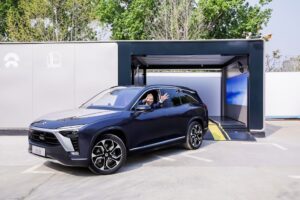Battery swap stations in Europe offer an alternative to long waits at EV charging stations
Tuesday, April 11, 2023
By Roselyne Min with AP. The European Union hopes to have 30 million zero-emission electric vehicles (EVs) on its roads by 2030 and plans to ban sales of new petrol and diesel cars from 2035.
But right now, long charging times are often a deal breaker for drivers considering switching to an EV.
That wait for batteries to charge may soon become a thing of the past.
Chinese EV maker NIO has opened its first European “Power Swap Station” in Denmark where drivers can stop by to replace their used-up battery with a fully charged one.
Once the car enters the station, the entire process is autonomous: the station raises the vehicle, mechanically unscrews and removes the depleted battery and replaces it with a charged one, adding up to 500 km of range.
The whole process takes about five minutes.
Meanwhile, the station slowly charges the batteries it has in stock. NIO says that when batteries are charged slowly, they degrade more slowly, too, and end up lasting longer.
Demand for EVs is soaring. Is Europe’s charging station network up to speed?
There are over 1,100 Power Swap Stations already in operation worldwide, mostly in China, according to NIO. It now plans to open over 100 stations across Europe this year.
“What we’re building now is what we call a travel product. We’re putting the stations up in between major cities, allowing people that normally drive far. And then, next wave, we’ll put them closer to the major cities and traffic hubs, sort of to broaden their perspective a little,” said Michael Salomon, interim head of power at NIO Denmark.
According to the company, 80 per cent of Danish EV drivers charge their cars in their driveway.
NIO believes that their battery swap station will allow those who don’t have a driveway or an AC charger at home to have an operational battery whenever they need it.
Pros and cons of battery swapping.
Experts say there needs to be a common standard for power swap stations like these to work efficiently.
“The main disadvantage of NIO Power Swap is that you have to drive in a NIO car to use the new battery power swap stations,” said Morten Haagensen Elmose, of the Danish Electric Vehicle Association.
But he does see some potential for the technology, perhaps for drivers unable to charge at home or unwilling to change their driving habits.
“If you’re actually considering making the transition from an ICE (internal combustion engine) car to an EV, and you are not so keen on the idea of charging at all, then this could actually make sense with battery swap to that kind of drivers,” he said.
EVs explained: How do electric cars actually work and are they really better than traditional cars?
Battery swapping is not a new concept. California-based EV brand Better Place, which touted battery switch stations, filed for bankruptcy in 2013.
Ten years on, NIO believes it will be luckier given the EU’s zero-emissions targets, and that widespread use and growing demand for electric cars could make the concept a hit with drivers.
The brand aims to have more than 2,300 Power Swap Stations globally by the end of this year.
